Authors: imajinl, Paul Timofeev, Shoal Research
Translation: Yangz, Techub News
Why the Future of Multi-Chain is Inevitable
The future of multi-chain with hundreds of chains is inevitable. Over time, almost every team and developer hopes to have their own economic benefits and users, even though this can be achieved in a general execution environment like Solana, applications depend on the throughput of the environment, and history has proven that these environments are sometimes unreliable. If we believe that the paradigm shift to blockchain technology is imminent, then the next logical conclusion is to provide hundreds of dedicated execution environments for applications built on blockchain technology. Today, this situation has already emerged, with applications like dYdX, Hyperliquid, Frax, and other new projects becoming independent application chains and Rollups. In addition, L2 scaling solutions are also likely to coexist with L1, as smaller node groups have significantly faster communication speeds globally than larger node groups. This will allow L2 (such as Rollup) to scale almost without limits, while inheriting the security of L1 and having a 1/N trust assumption (rather than requiring a large number of participants to reach consensus as L1 does). Essentially, we envision a future with hundreds of L1 and L2.
However, even in the current situation with only dozens of L1 and L2, some people still have concerns about user experience. Therefore, the future of multi-chain needs to overcome many issues, including fragmented liquidity, the complexity of end users using multiple cross-chain bridges, RPC terminals, different Gas tokens, and markets. So far, there is no way to completely abstract the complexity of user experience in the current situation. If the multi-chain ecosystem continues to develop without first addressing these significant user experience barriers, it is imaginable how unusable blockchain will be for end users.
The reason the Internet has developed to where it is today is not because users understand its core protocols, such as HTTP, TCP/IP, UDP. Instead, it abstracted the technical details, allowing laypeople to use it. Over time, blockchain and native blockchain applications will do the same.
In the cryptocurrency field, users need to deploy liquidity across multiple L1 and L2 chains to meet suboptimal user experiences and understand the technical details of these systems. It is now time to abstract everything - for the average user, they do not need to know that they are using blockchain, let alone how many L1 and L2 chains are underneath, as this is the only way for the industry to achieve mass adoption.
Why Chain Abstraction Can Solve All Problems
Chain abstraction is a means to abstract the subtle differences and technical details of blockchain for ordinary users, thereby providing a seamless user experience. It can be said that the breakthrough in user experience may be the missing piece for the next generation of enterprises and users to enter the blockchain and native crypto ecosystem.
Understanding the Components of Chain Abstraction in Depth
Before introducing the foundational infrastructure projects that are crucial to achieving chain abstraction in the future, it is necessary to first understand some of the technical components of chain abstraction.
Account Abstraction
Today's wallets face many limitations. In addition to various security vulnerabilities, they can only provide limited functionality unless used in conjunction with other smart contracts. Imagine what would happen if externally owned accounts (EOAs) were transformed into smart contract wallets (SCWs)? Unlike EOAs, SCWs cannot initiate transactions independently (they require prompts from EOAs). By merging the functionality of both, we can effectively transform EOAs into SCWs, allowing them to not only initiate transactions, but also execute complex, arbitrary logic, which is the premise of smart contracts.
The merging of the two can unlock a multitude of use cases, and here we will focus specifically on its relationship with chain abstraction.
When EOAs are converted to SCWs, the separation of who executes transactions and who signs transactions can effectively take place. This means that users do not need to execute transactions directly, but can have mature actors (referred to as executors) execute them on their behalf. It is worth noting that in this process, users do not give up custody of their wallets, as they retain their private keys. Having executors also has other benefits, such as not needing to maintain Gas balances on all different blockchains, as transaction/Gas fees can now be abstracted away. In addition, users only need to click a button to execute bundled transactions. For example, approving the use of a certain token for DEX, making an exchange, and then lending the proceeds to the Aave market.
With executors, there is no need to interact directly with smart contracts, while users can still retain custody of their funds. Imagine how cool it would be to use any blockchain application through a Telegram bot, and account abstraction technology can make it possible.
Furthermore, account abstraction allows users to self-custody assets and open DeFi positions on many chains without needing different wallets, RPC, or worrying about different signature types, without even considering which chain is being used. (More demonstrations and articles on account abstraction)
Moreover, account abstraction eliminates the need for users to hold private keys to protect their accounts from third-party management. In addition to social recovery, users can choose more traditional verification methods, such as 2FA and fingerprint, to ensure wallet security. Social recovery can be used to recover lost wallets through users' family members, for example.
"The next billion users won't write down 12 words on a piece of paper. Ordinary people won't do that. We need to provide better usability for them; they don't need to think about cryptographic keys." - Yoav Weiss, EF
As wallets are the entry point for encryption and blockchain, account abstraction will ultimately drive the flourishing of chain abstraction.
For more details on how account abstraction works internally, refer to Jarrod Watts' post.
Intent
Intent refers to allowing experienced participants or "solvers" to execute transactions on behalf of users in the most optimal way. In simple terms, it is to achieve the user's on-chain operations in the most optimal way off-chain. For example, when you submit an order to CowSwap, you are actually submitting an intent to exchange the above token for another token at the best price. By submitting this intent off-chain, it bypasses the public mempool and directly routes to an encrypted private mempool, where solvers will compete to satisfy or resolve your intent at the most optimal price, whether using their own balance sheets, private order flows, or using on-chain liquidity venues such as Uniswap and Curve. In this way, the profit of the solvers will be compressed to zero, providing the best execution for users.
Now that we have defined intent, how does it help us achieve chain abstraction?
The answer goes back to the boundary between signers and executors in account abstraction. If all the user needs to do is click a button to sign a transaction, they can outsource all on-chain requirements to mature participants, who are responsible for finding the best way to execute. Then, these mature participants take on the risk of interacting with different applications on L1 and L2, related Gas fees for different tokens on different chains, reorganization risks, and other execution risks. By taking on these steps and risks, solvers will price the fees charged to users accordingly. In this case, users do not need to consider the various complexities and related risks of using on-chain products and services, but can outsource them to mature participants, who will charge users accordingly. Since there is competition among solvers, the fees charged to users will be compressed to almost zero, as there will always be solvers ready to lower the prices of the winning solvers of the order flow. This is the magic of the free market - through competition, users will enjoy better services at lower prices.
Here is the translation of the provided markdown:
Example: How Intent Works in the Current Environment
For example, if I have ETH on Ethereum and want to obtain SOL on Solana at the best price, I can use the Request for Quote (RFQ) system to transmit the order flow in the Intent market. Within a few seconds, I can hold SOL on Solana. It's worth noting that Ethereum has a block time of 12 seconds, which means that even though solvers do not have settlement guarantees, they can be fairly certain that the USDC deposit transaction is valid and will go through by running their own nodes. Additionally, by using their own balance sheets, solvers can pre-fund the purchase of SOL on Solana and essentially fulfill the intent before receiving the funds. Since the risk is not borne by the user but by mature participants, users can achieve their intent with sub-second latency and the best price without knowing the cross-chain bridges, RPC, or gas costs.
In this case, users still know which chain they are using. This example illustrates how intent operates in the current environment rather than in a fully abstracted chain. Intent does not stop there; there are even more possibilities.
It is not difficult to imagine that in the future, intent will meet all user needs. Users will be able to specify what they want to do and have it done in the most efficient way. For example, a user may want to borrow DAI with ETH and deposit the DAI into a liquidity pool to earn CRV rewards. In this example, authorized solvers will compare the borrowing rates for all DAI and ETH and borrow at the lowest rate. Then, the solvers will deposit the DAI into a vault similar to Yearn, automatically convert the highest yield into CRV, and transfer it to the user's wallet.
However, it is important to note that risk is subjective and cannot be expressed through intent, unlike other objective inputs such as the maximum price slippage of a transaction. So, which lending markets, liquidity pools, and chains are available to fulfill this intent? After all, each market has different risk conditions and trust assumptions. This is where authorized solvers come in. Each authorized solver is to some extent trusted by the user and can fulfill the user's intent based on pre-expressed risk and trust preferences. For example, a user can specify not to deposit into "risky" contracts. However, it is likely that only advanced users will specify a large number of subjective preferences to solvers. Even more mature participants (HFT, MM, VC, etc.) may directly interface with the chain to avoid solvers charging any fees and customize their own risk and trust assumptions. Users with some knowledge of blockchain may choose from presets (e.g., low, medium, or high risk), and solvers can act based on these presets.
Using a group of authorized solvers to meet subjective user needs encourages competition among solvers to fulfill user orders in the best way possible without causing any trouble for the user. Additionally, users can revoke the executor permission of solvers at any time, creating a system of checks and balances. This way, solvers are incentivized to remain honest and follow user preferences, as different solvers can prove malicious behavior towards the user who initiated the order flow.
Of course, intent is still a work in progress, and speculation about how intent will evolve into more complex technologies is just that - speculation. However, seeing intent develop in this way is not surprising. We believe that intent will play the most important role in achieving the future of chain abstraction.
CowSwap and deBridge are two projects focused on intent. We have already introduced CowSwap and its intent-based architecture. Similar to CowSwap, deBridge also adopts an intent-based architecture, but its purpose is to achieve lightning-fast cross-chain transactions. Like most intent-based solutions, deBridge utilizes a network of solvers composed of MM, HFT, and other mature participants to pre-fund the funds on the source chain before collecting the user's funds and pre-funding on the target chain. In addition to encouraging solvers to compete to provide the best execution for users, deBridge also differentiates itself by transferring risks (such as reorganization risks) and other inconveniences (such as gas fees and different RPCs on different chains) to solvers.
The image below shows the deBridge model. In the example below, a user holding a stablecoin in USD on Solana wants to have a stablecoin in EUR on Ethereum. They express their intent to deBridge, which propagates it to the network of solvers, allowing solvers to exchange their ETH on Ethereum for the stablecoin ethEUR. After the deBridge validator group verifies that the solvers have fulfilled the user's intent on the target chain (in this case, providing ethEUR to the user), deBridge quickly unlocks the user's funds on the source chain (in this case, Solana) and gives them to the solvers. It is important to note that the user does not need to wait for verification before receiving the funds on the target chain.
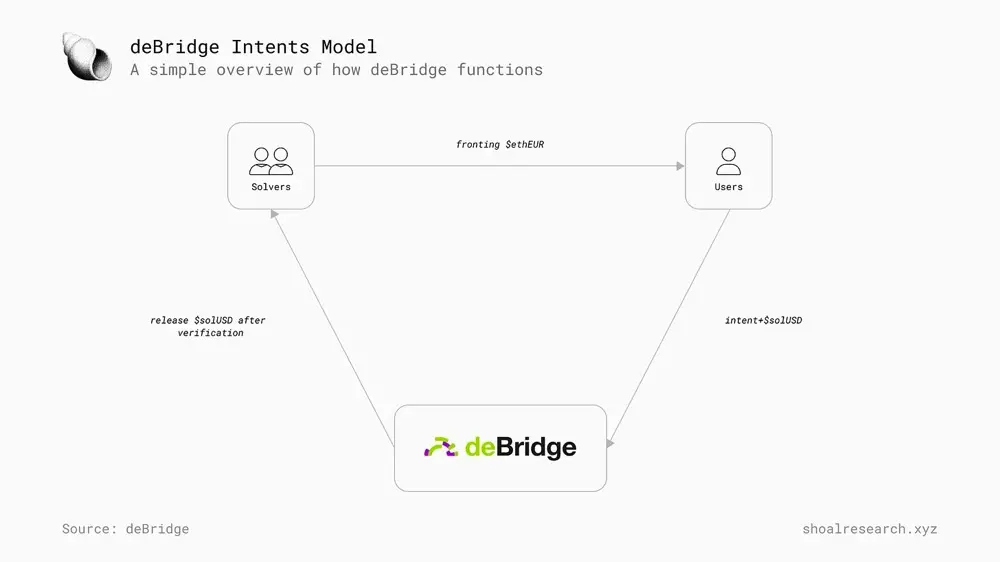
Liquidity Aggregation
One of the increasingly evident developments in the future of multi-chain is the extreme fragmentation of liquidity. In a world with hundreds of Rollups, validiums, L1s, etc., each hosting liquidity on its own network, the end-user experience will deteriorate due to fragmented liquidity pools.
If all liquidity in the cryptocurrency market were hosted by a single CEX instead of hundreds of CEXs and more on-chain DEXs (all sharing the same liquidity pool), the execution for end-users would likely be optimal, apart from the review and overall centralization issues. However, this is just a hypothesis, as it is not feasible in the real world of fierce competition and decentralized forces.
The emergence of DEX aggregators is an important step in user experience, as it aggregates decentralized liquidity sources in a unified interface within a single network. However, as the inevitable future of multi-chain begins to emerge, DEX aggregators will no longer be applicable, as they can only aggregate liquidity on a single chain and cannot aggregate multi-chain liquidity and its sources. Additionally, for blockchains like Ethereum, the associated gas costs for transferring liquidity between multiple source chains or between chains make using aggregators more expensive than sourcing liquidity directly. This pattern can achieve greater success on low-cost, low-latency networks like Solana, although the aggregators themselves are still limited in their ability to route trades to liquidity sources.
In the future of chain abstraction, having technology that aggregates decentralized liquidity is crucial, as the ideal user experience will be chain-agnostic and likely rely on third-party solvers to provide execution services. Many teams are developing solutions aimed at addressing the fragmentation of multi-chain liquidity, and below we will mainly introduce Polygon AggLayer and Optimism Superchain.
Polygon AggLayer
As described on the Polygon website: "AggLayer will be a decentralized protocol consisting of two parts: a universal cross-chain bridge and a ZK-driven mechanism, which provides cryptographic security guarantees for seamless cross-chain interoperability. By providing security through ZK proofs, chains connected to AggLayer can maintain sovereignty and modularity while retaining a seamless user experience on a single chain."
Fundamentally, there is a typical bridging between Ethereum L2 scaling solutions and Ethereum. This means that all user funds bridged from Ethereum to L2 reside in this bridging contract. However, this disrupts the interoperability between different L2s and their ability to seamlessly communicate data and transfer value between them. For example, if you want to move from Base to Zora (both Ethereum Rollups), as shown in the image below, you need to spend 7 days for the withdrawal process, first from Base to Ethereum, and then from Ethereum to Zora. For OP-type Rollups like Base, time is needed to challenge bridging transactions with fault/fraud proofs. This is not only a lengthy process but also costly due to the interaction with the Ethereum main chain.
Polygon AggLayer disrupts this process. As shown in the image below, all chains share a cross-chain contract with other chains utilizing AggLayer.
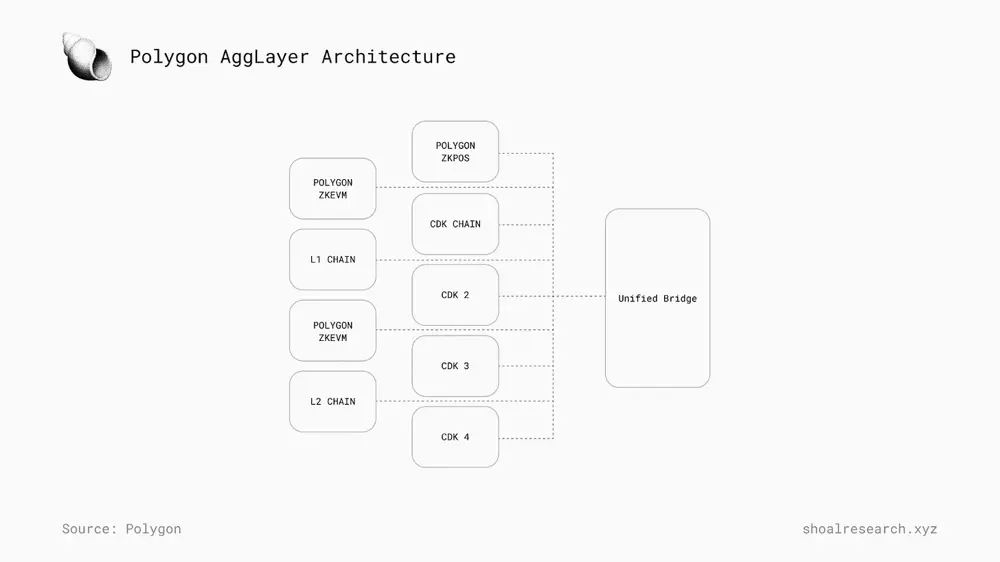
Operation of AggLayer
The core of AggLayer is the aggregation of zero-knowledge (ZK) proofs from all connected chains to facilitate cross-chain transactions. AggLayer is essentially an aggregation site where all supported chains publish ZK proofs to demonstrate certain actions taking place.
To further illustrate this, let's consider how it operates in practice. In this example, we assume that all mentioned chains are connected to AggLayer.
A solver detects a request or intent from a Base user. The user holds ETH and wants to purchase 3000 DAI worth of NFT on Zora. Since the solver does not have DAI, they must quickly find the best way to fulfill this intent. They discover that DAI on Optimism is cheaper than on Zora. Therefore, the solver would publish a proof to AggLayer, demonstrating that the user holds ETH on Base and wishes to obtain the corresponding amount of ETH on Optimism. Since the cross-chain contract is shared, only one ZK proof is needed to transfer the same amount of fungible assets from chain "X" to chain "Y".
After publishing the ZK proof and unlocking the corresponding amount of ETH on Optimism, the solver would swap for DAI and go through the same process to obtain the same amount of DAI on Zora, then complete the NFT purchase. Behind these processes, AggLayer settles these ZK proofs with Ethereum, providing stronger security guarantees for end-users and chains connected to AggLayer.
However, in this scenario, solvers/users/other actors bear inventory risk. This risk can manifest in various forms, such as arbitrage on Optimism's DAI, rising NFT costs, ETH price decline, or any other risks between the generation and execution of user order flow, resulting in losses for the relevant parties. Single-chain DEX aggregators have atomic composability, while solvers interacting with different state machines do not. Atomic composability ensures that all operations are executed in a single linear sequence, either all successful or all failed. This is because due to the potential risk of reorganization (on the target chain), there is always at least one block delay between different state machines.
However, this does not mean that the above use case is impossible. Not only are there tail events, but solvers and other mature participants can also bear these risks and compensate for them by pricing to users, for example, by offsetting losses (if they occur) or using their own balance sheets to fulfill user intent.
Optimism Superchain
Another example of liquidity aggregation is Optimism Superchain. According to the definition in the Optimism documentation, Superchain is "a chain network that shares cross-chain, decentralized governance, upgrades, communication layers, and more, all built on the OP Stack." The project focuses on aggregating liquidity, similar to AggLayer. Superchain will allow all chains as part of it to use a shared cross-chain contract. This is the first step in aggregating liquidity between chains in Superchain.
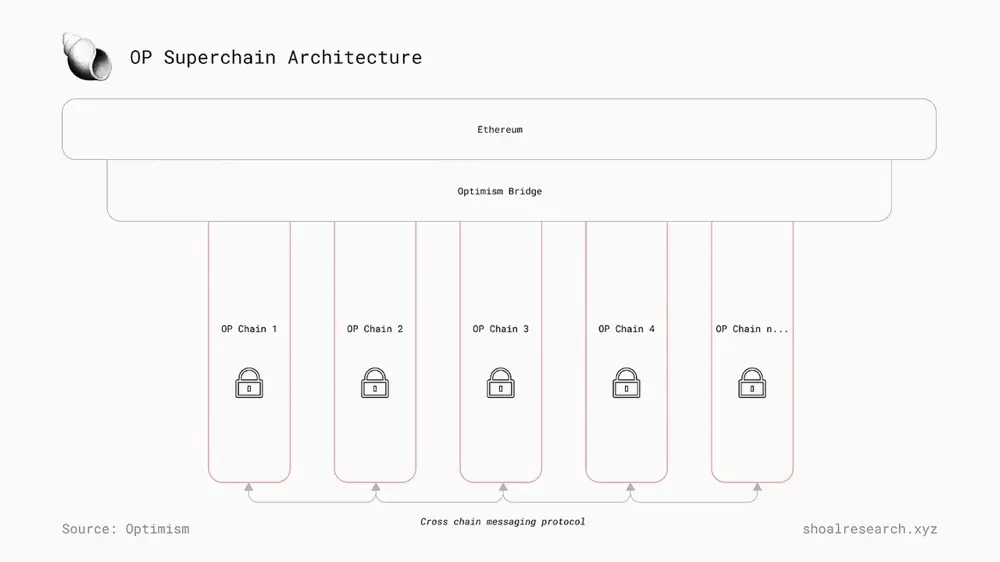
The difference between Superchain and AggLayer is that AggLayer relies on ZK proofs for a seamless experience, while Superchain relies on a shared sequencer. This article does not delve into the details of the shared sequencer, but you can refer to this article to understand how the shared sequencer unleashes advantages in cross-chain seamless interoperability and to some extent, atomic composability.
As Superchain mandates that chains joining must use the shared sequencer, it may limit the execution environment available to the chains joining. Additionally, there will be other cumbersome challenges, such as chains not being able to access their user-created MEV, and other challenges outlined in this article. However, teams like Espresso are researching how to reallocate the MEV enabled by chains using the shared sequencer. Furthermore, all chains connected to Polygon AggLayer also need to use the same ZK circuit, which also limits the execution environment available to chains connected to AggLayer.
The "CAKE" Framework for Chain Abstraction
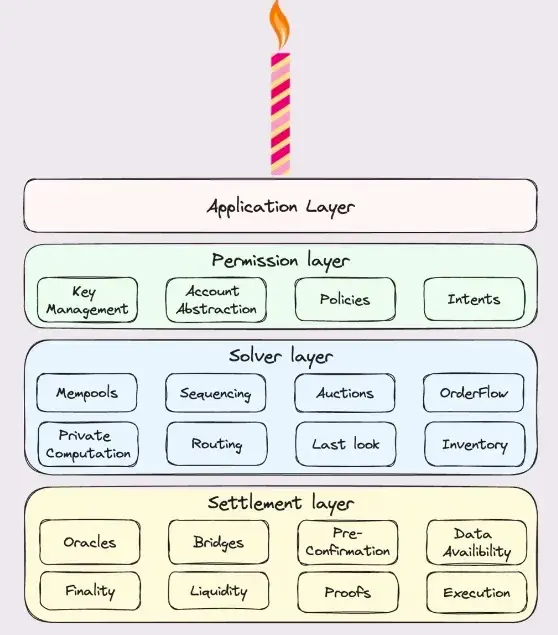
Frontier Research has developed the CAKE (Chain Abstraction Key Elements) framework. The framework outlines three layers (excluding the user-facing application layer) required to achieve the following state:
"In the world of chain abstraction, users access dApp websites, connect wallets, sign intent operations, and then wait for final settlement. The complexity of acquiring assets required for the target chain and final settlement has been abstracted from the user end and occurs in the infrastructure layer of CAKE."
The framework defines the three foundational layers of CAKE as the permission layer, solver layer, and settlement layer. We have already discussed the solver layer and permission layer. The permission layer includes account abstraction and strategies - what we call authorization, while the settlement layer includes underlying technologies such as oracles, cross-chain bridges, pre-confirmation, and other backend functionalities.
Therefore, the settlement layer is expected to bring significant benefits to solvers and other mature participants, as well as user-facing applications, as the settlement components in this framework can collectively help solvers manage risks and provide better execution for users. This will further extend to other components such as data availability and execution proofs. These are all requirements for blockchain to provide a secure building experience for application developers and ultimately deliver security to end-users.
The CAKE framework encompasses many of the concepts mentioned in this article and provides a coherent way to view the various components of chain abstraction and their interrelationships. Readers interested in the framework can read this introductory article.
Case Studies in Chain Abstraction
We have introduced several projects that are actively working towards realizing the future of chain abstraction, and here are a few more projects.
Particle Network
Particle Network is rolling out a modular L1 based on the Cosmos SDK, which will operate as a high-performance execution environment compatible with EVM. Initially, Particle emerged as an account abstraction service provider, enabling users to create smart contract wallets linked to their Web2 social accounts and then use them in dApp embedded interfaces. Subsequently, the protocol expanded its services, aiming to promote chain abstraction in a broader blockchain field through its wallet, liquidity, and gas abstraction service suite on its L1.
Similar to other chain abstraction service providers, Particle envisions a future where anyone can easily transact across multiple chains with a single account and pay gas fees in any token they desire. Therefore, the underlying L1 will act as a coordinator for a multi-chain ecosystem, unifying users and liquidity in both EVM and non-EVM domains.
Particle Chain Abstraction Stack
Universal Accounts (UA)
From the end user's perspective, Particle's chain abstraction stack begins with first principles - creating accounts. The universal account on Particle is an ERC-4337 smart account attached to a pre-existing EOA (Externally Owned Address), which aggregates token balances from multiple chains through automatic routing and execution of atomic cross-chain transactions to a single address. Traditional cryptocurrency wallets can be used to create and manage accounts, and Particle's WaaS also allows users to register using social logins.
To abstract the various complexities of native blockchain operations, the function of UA is to build a unified interface on top of existing wallets, allowing users to deposit and use tokens in multiple blockchain environments as if they were on a single chain. To keep accounts in sync between UAs, account settings will be stored on Particle L1 as the central source of truth for each instance. The network will then facilitate cross-chain message passing to deploy new instances or update existing ones.
Therefore, Particle L1 serves as the coordination and settlement layer for all cross-chain transactions handled through user protocols.
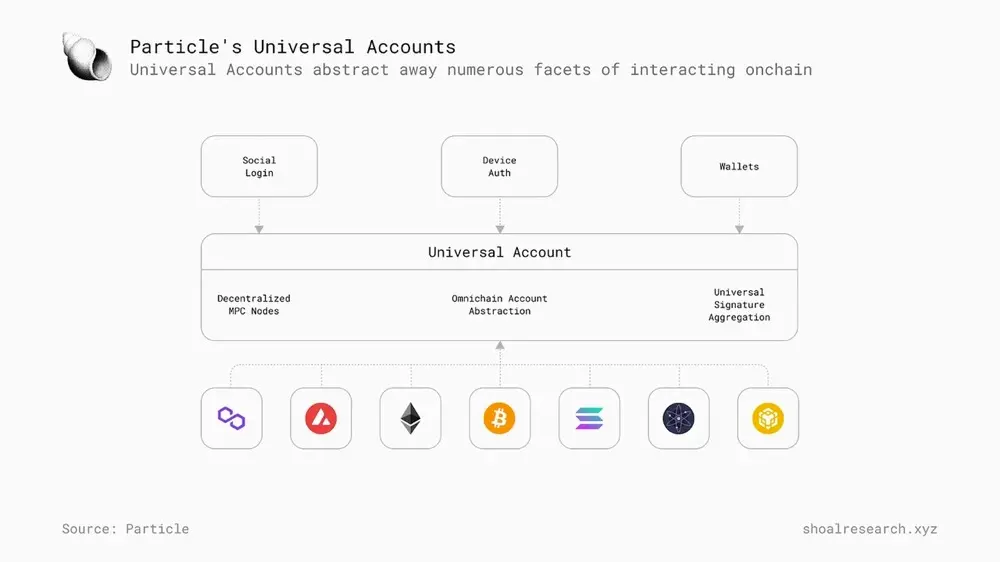
Universal Liquidity
Another key component of Particle's chain abstraction service is the universal liquidity feature. The user protocol provides a way for users to express transaction requests through an interface, and universal liquidity is responsible for automatically executing these requests, thereby unifying balances across different networks. This functionality is crucial for enabling cross-chain transfers, as the current barriers to entry (such as purchasing native Gas tokens and creating native wallets for new networks) would otherwise hinder cross-chain transfers.
For example, when a user wishes to purchase assets on a blockchain that has never been used and has no funds, the required liquidity will automatically be sourced from the user's existing balances, which may be on different chains and in different tokens. This is largely achieved through Particle's decentralized message passing network (DMN), which supports dedicated services (called relayer nodes) to monitor off-chain and on-chain state events settlement. Specifically, relayers in the DMN use a message passing protocol to monitor the state of user operations on external chains and then settle the final execution state to Particle L1.
Universal Gas
The third pillar of the Particle chain abstraction stack is the implementation of universal Gas tokens. Through interaction with Particle's UA, universal Gas allows users to pay gas fees in any token.
When a user wishes to execute a transaction through Particle UA, the interface prompts the user to select a Gas token, and then automatically pays through Particle's native Paymaster contract. All Gas payments are settled on their respective source and target chains, with a portion of the fees converted into Particle's native PARTI token, settled on Particle L1.
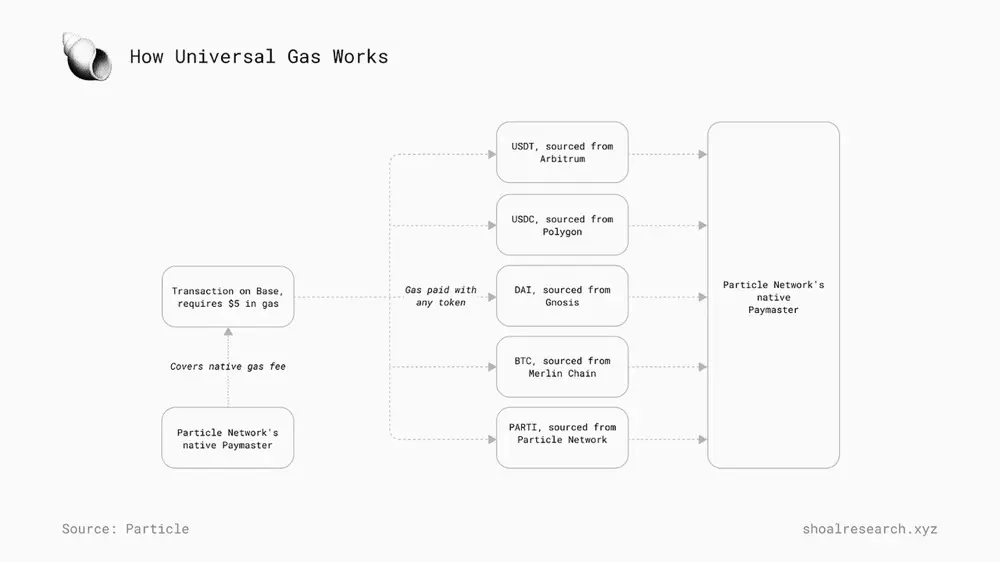
Particle builds upon its existing account abstraction infrastructure, with reported wallet activations exceeding 17 million and user operations exceeding 10 million. Particle L1 is not directly competing with existing blockchains; instead, it aims to provide an interoperability layer, collaborating with key teams in the chain abstraction service space (including Near and Cake development teams) to connect them.
Particle Network L1 is currently in the testnet phase, allowing early participants to test universal Gas in experimental UA implementations.
Near Protocol
As a sharded proof-of-stake L1, Near's core revolves around bridging the gap between native blockchain applications and mainstream audiences. Near achieves this through account aggregation. Account aggregation is a multi-layered architecture designed to abstract key pain points of using blockchain networks, such as switching wallets, managing gas fees, and cross-chain operations. It aggregates all operations into a single account.
Near Chain Abstraction Stack
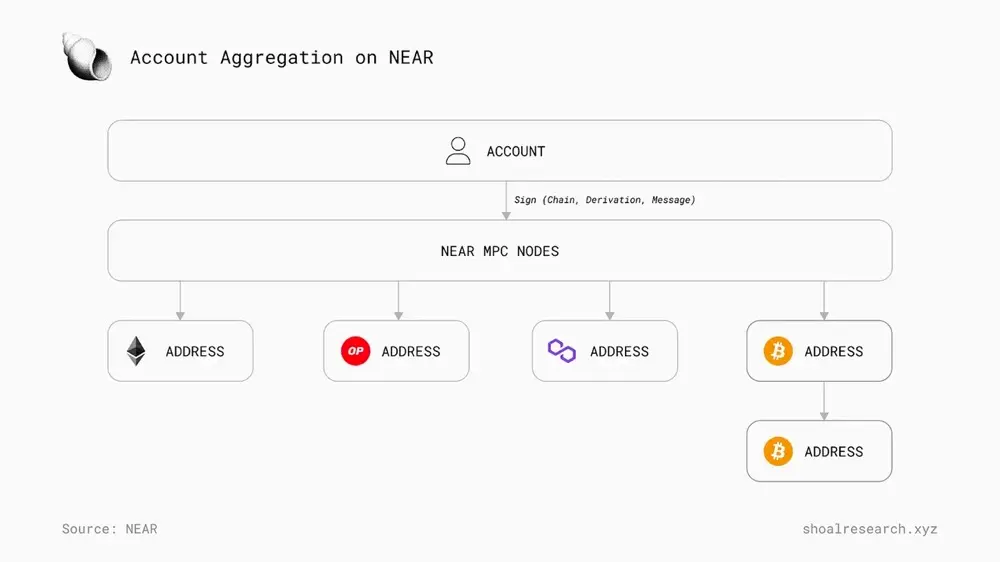
Near Accounts
In addition to the alphanumeric public key hash standard on most blockchains, Near's proprietary account model also maps each account to a more readable account name, such as alice.near. Near accounts also use two types of access keys, each with different properties and underlying functionalities, allowing accounts to manage multiple keys across multiple chains, each responsible for various permissions and configurations:
- Full Access Keys: These keys are used to sign transactions and effectively operate on behalf of the account, and should never be shared.
- Function Call Keys: These keys are used to specifically sign calls to specific contracts or sets of contracts.
Near's proprietary key management system, FastAuth, lowers the barrier to entry and further abstracts blockchain for end-users. FastAuth allows users to register native blockchain accounts with just an email address and uses passkeys (biometrics replacing passwords) instead of lengthy and complex private keys and passwords.
Multi-Chain Signatures
Multi-chain signatures are a key component of Near's chain abstraction, allowing any NEAR account to have related remote addresses on other chains and sign messages, execute transactions from these addresses. To achieve this, multi-chain signatures use the NEAR MPC (Multiparty Computation) network as signers for these remote addresses, eliminating the need for explicit private keys. This is made possible through a novel threshold signature protocol, which implements a form of key sharing, allowing MPC signers to maintain the same total public key even as key shares and nodes change.
By making MPC signers part of the NEAR network, smart contracts can initiate the signature process for account creation. By using different combinations of chain IDs, NEAR account IDs, and specific paths, each account can create an unlimited number of remote addresses on any chain.
Meta Transactions
Another key issue currently hindering the development of seamless user experiences in a universal blockchain environment is that each blockchain requires payment of gas fees in its native token, requiring users to acquire these tokens before using the underlying network.
NEP-366 introduces meta transactions to Near, allowing users to execute transactions on Near without owning any gas or tokens on the chain. This is achieved through third-party service providers called Relayers, who receive signed transactions and forward them to the network, attaching the necessary tokens to subsidize their gas fees. From a technical perspective, the end-user creates and signs a SignedDelegateAction (containing the data required to construct the transaction) and then sends it to the relaying service. The relaying service uses this data to sign the transaction, sends the SignedTransaction to the network via RPC calls, and ensures that the relaying service pays the gas fees when executing operations on behalf of the user.
Other Notable Chain Abstraction Projects
Here are other teams building solutions for chain abstraction services that are worth paying attention to. This list may not be exhaustive, but it provides a foundation for those interested in further researching chain abstraction models.
Connext
Connext is a modular interoperability protocol that defines chain abstraction as "a pattern that improves the dApp user experience by minimizing the user's attention to the chain they are on" in its blog (May 2023), accurately describing the core principles around which chain abstraction service providers are currently building. Connext provides application developers with a set of smart contract modules through its Chain Abstraction Toolkit, with its core functionality being xCall, a basic feature that allows smart contracts to interact with each other in different environments. The xCall feature enables the initiation of fund transfers, calldata, and/or various cross-chain transfers, which the Chain Abstraction Toolkit encapsulates into simple logic for developers to use.
Socket Protocol
Socket Protocol provides infrastructure for application developers to build interoperability-centered products and services, enabling secure and efficient cross-chain data and asset transfers. Socket 2.0 marks the protocol's transition from cross-chain services to chain abstraction services, with its flagship product, Modular Order Flow Auction (M OFA), being a highlight. The mechanism aims to provide a competitive mechanism for an efficient chain abstraction market. Traditional OFA involves a network of various participants performing specialized tasks, competing to provide the best results for end-users' requests. Similarly, the purpose of M OFA is to provide an open market for execution agents called "Transmitters" and user intents. In M OFA, transmitters compete to create and complete chain abstraction bundles, or ordered sequences of user requests that require data and value transfer across multiple blockchains.
Infinex
Infinex is building a unified user experience layer aimed at integrating decentralized applications and ecosystems. Its flagship product, Infinex Account, is a multi-layered service that serves as a platform to integrate any on-chain application into a simplified user experience for end-users. At the core of Infinex Account is a set of cross-chain smart contracts that can be controlled, secured, and recovered through standard Web2 identity authentication.
Brahma Console
Brahma Finance is building its flagship product, Console, which is an on-chain execution and hosting environment designed to enhance the DeFi user experience, particularly focusing on the EVM blockchain ecosystem. Brahma uses batch transactions and chained transactions to synchronize transactions across different chains and uses smart accounts for on-chain interactions. The end result is seamless cross-chain interactions within a single user interface.
Agoric
Agoric is a native L1 of Cosmos, designed with an asynchronous, multi-block execution environment to be the preferred environment for developing cross-chain applications. Agoric utilizes the Cosmos IBC protocol for interchain communication and leverages Axelar's Generalized Messaging Protocol (GMP) for interactions outside the Cosmos ecosystem. By abstracting the complex issues involved in cross-chain communication and smart contract execution, Agoric's Coordinated Application Interface (API) simplifies the developer experience, while end-users benefit from applications with inherent chain abstraction capabilities.
Summary
After writing all of this, the benefits of chain abstraction for end-users should be quite clear. The complexity of using native blockchain applications will be completely abstracted into a unified interface layer, creating a global, chain-agnostic touchpoint for anyone looking to participate.
Equally important, chain abstraction can bring tremendous benefits to blockchain applications. Currently, Web2 developers do not need to "choose" where to deploy their applications. For example, anyone can use Airbnb as long as they have an internet connection. However, in the Web3 environment, developers need to choose the deployment environment for their applications (e.g., on Ethereum, Solana, or Cosmos). This not only limits the TAM (Technology Acceptance Model) but also means that developers need to choose the "right" chain for deployment. This choice is difficult but crucial. Some applications are excellent in themselves but may struggle due to the underlying blockchain. Furthermore, as the blockchain industry continues to evolve, the so-called "right" chain may also change. In the future of chain abstraction, application developers will no longer need to choose a chain that is crucial to their success.
It is clear that we are moving towards a multi-chain future, which will inevitably exacerbate user experience issues and hinder mainstream applications. We believe that chain abstraction and its various components are a viable solution to today's cryptocurrency user experience issues.
免责声明:本文章仅代表作者个人观点,不代表本平台的立场和观点。本文章仅供信息分享,不构成对任何人的任何投资建议。用户与作者之间的任何争议,与本平台无关。如网页中刊载的文章或图片涉及侵权,请提供相关的权利证明和身份证明发送邮件到support@aicoin.com,本平台相关工作人员将会进行核查。




